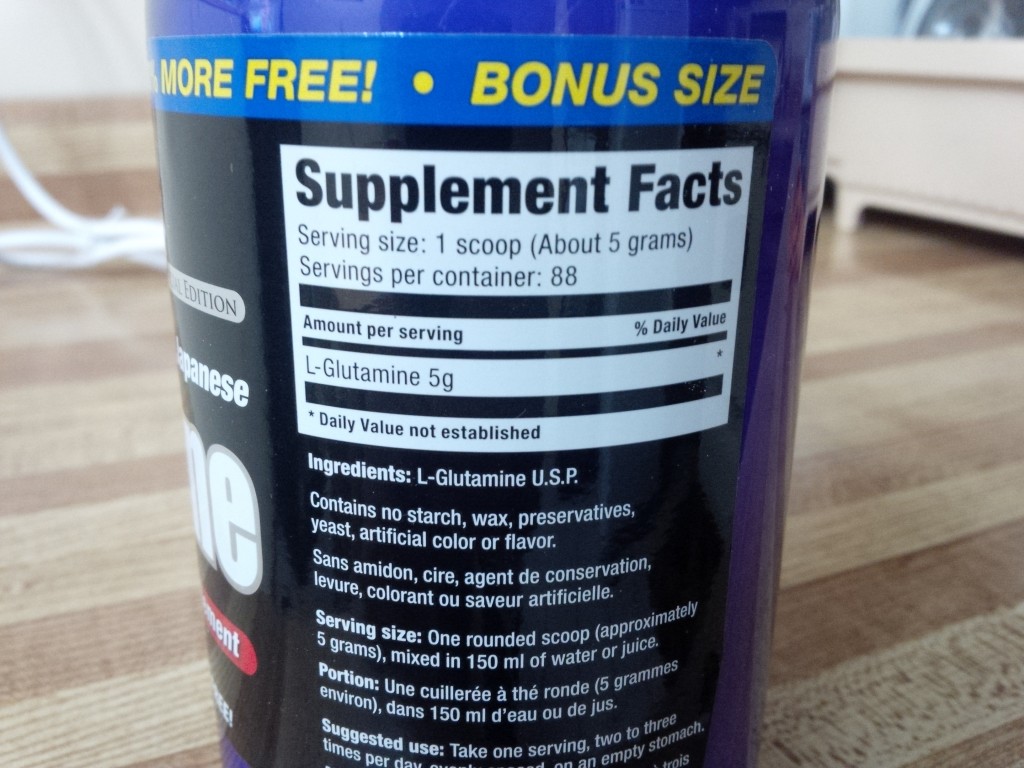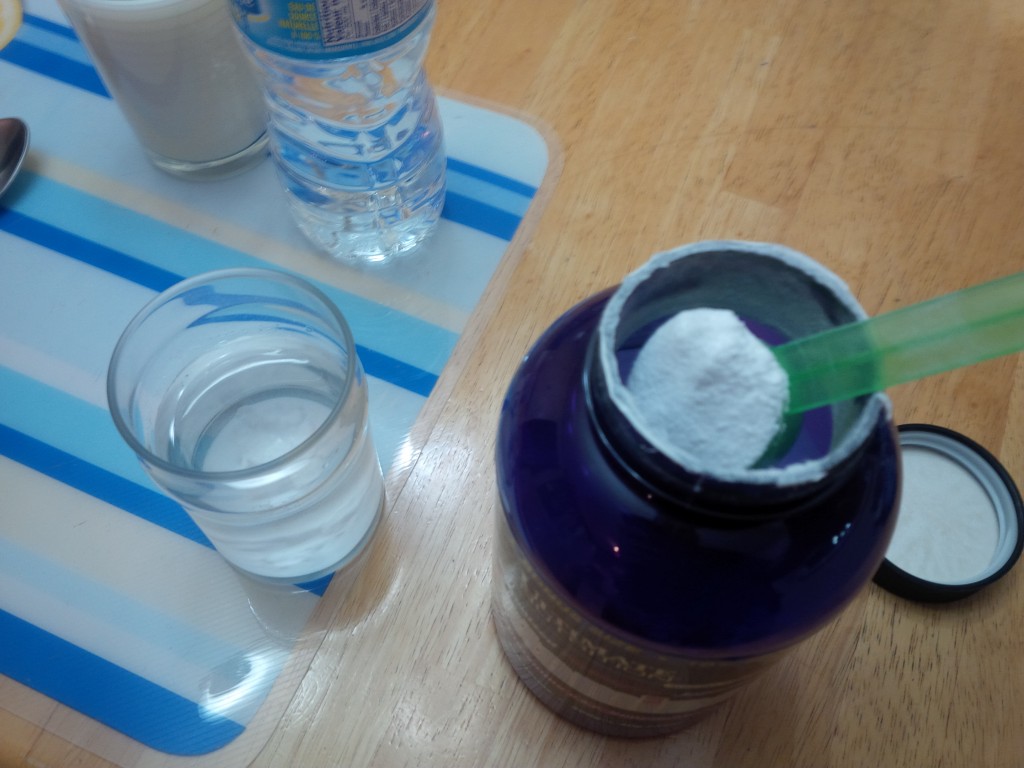The Glutamine Experiment
Along the lines of things I never said I’d do (or do again), I’m taking a new artificial supplement: Glutamine. I’m a little embarrassed that I’m resorting to using another supplement, but I’ll take the chance and document the process for others to see.
In the summer of 2012, I was convinced to buy into a system of nutritional supplements called ViSalus. It was essentially a meal replacement or protein powder. I even did weekly updates for about 9 weeks and lost about 9 pounds. Using such an artificial thing kinda worked, but it wasn’t sustainable because I later got all that weight and then some. Further, I fear it caused long-term damage to my digestive system. Since that summer of powdered breakfasts, my stomach has been especially sensitive to dairy and gluten products. So, since then I’m really suspicious of artificial products, especially artificial sweeteners.
However, as full disclosure, I do regularly take some artificial products: I take a daily multivitamin/multi-mineral supplement pill. And I take a daily (sometimes twice daily) dose of Omega-3’s through a fish oil capsule. I do loathe artificial products, but I have an appreciation for how necessary they may be if diet alone isn’t enough.
There are a few reasons why I was willing to eschew my principals and try something new: The first reason was that I was REALLY sore from workouts, especially weight training. The second was that I had started to suspect I had “leaky gut syndrome”.
Muscle soreness following workouts is nothing new to me. Delayed Onset Muscle Soreness (DOMS) is supposed to be a sign that the workout was hard enough and is causing my body to react and adapt. But when the soreness lasts 2-3 days and impedes my subsequent workouts and runs, I start getting concerned. I see people at the gym with their post-workout shakes, and a lot of people recommended guzzling Creatine to reduce DOMS. But I honestly couldn’t bring myself to go back to those after my bad experience with the ViSalus shakes. I suppose it would take more than one reason to have me to have to resort to what I consider “extreme” measures.
My other motivation was to get my digestive system back on track. I’m starting to realize I have rather unpleasant food sensitivities, especially to certain varieties of corn, carrots, tomatoes, cream, and pastas. A friend I run with was talking about how she used to have “leaky gut syndrome.” From what I understand, is a condition where your small intestine membranes are hyperpermiable. That means that the lining of the small intestine is inflamed because of bacterial imbalance, toxins, or other reasons. This inflammation leads to unexpected fats and proteins getting into the bloodstream leading to an immune system response. This immune response leads to feelings of being lethargic, foggy-headed, and/or tired.

I’ve also read that Leaky Gut Syndrome may be exasperated by exercise. That doesn’t surprise me because it certainly would be a form of stress that could cause health side-effects. It’s a little curious and ironic that in the effort to get healthy I may be causing harm along the way.
One way to combat leaky gut syndrome is to reduce or eliminate the foods that trigger this response. I did an “elimination diet” early last summer to identify many of my food sensitivities. That was really helpful for me. There’s an even more drastic elimination diet getting a lot of hype right now called Whole30. Fellow Blogger Lisa is currently on the diet and is reporting her progress on her blog. My girlfriend just started Whole30 too. I’m reluctant to try it because my current regime seems to be working, but I’ll be watching their journeys closely and I may reconsider after they’re done.
Even though I’ve reduced or eliminated many of my food intolerance triggers, my digestive system still isn’t totally better. My running friend recommended I add an L-Glutamine supplement to my diet. Not only is Glutamine an amino acid that may help in DOMS recovery, but apparently it helps repair intestinal walls that may have been weakened by Leaky Gut Syndrome. After doing a lot of my own research and asking a lot of people about it, including other runners and my personal trainer, I decided to take the plunge and try it.
A lot of sites make Glutamine seem like a magic powder that fixes everything: It reduces DOMS; it improves your immune system; it heals Leaky Gut Syndrome, it lets you get ripped! But wait, there’s more! It also gives you clearer skin, can assist in weight loss, and give you longer life! If it sounds too good to be true, it probably is.
I got this 400 gram bottle from a health foods store near my gym. It was on sale because it was expiring in less than two months. But I knew I would finish it by then, and for a sampler size of about 80 doses, this sale seemed like it was meant to be.
Of course I’m leary. The packaging clearly says that the statements made on the bottle about health benefits have not been approved by the FDA, and I’m guessing not by Health Canada either. Since the supplements market is completely unregulated, I worry that this product could be laced with a steroid or something else nasty that speeds up results by gives dangerous side-effects.
The labels look like what you would expect on a food product. But upon further inspection, it’s merely a parody of the true amount of information you’d see from a grocery store package.
Actually consuming the product is another story. It doesn’t actually dissolve well. So, even though I really mix it thoroughly in water, I’m still essentially taking it as a shot and hoping to get as much of the powder down my throat.
There are some complications:
I read that I’m not supposed to take it with creatine, because they share the same “delivery channels” in the bloodstream and could cancel each other out.
The packaging I have says to take it with water or juice. I was used to taking supplementary powder with dairy milk or almond milk, but I can deal with just water.
I have also had conflicting information on when to take it: My personal trainer said to make sure to take it with protein because that speeds its uptake. The packaging says to take on an empty stomach. And other sources say to take at the end of a meal!
Week 1 Status
I’ve been taking Glutamine for just over a week now. I usually take a 5 gram dose with my typical breakfast, and usually with my post-workout snack.
I haven’t experienced any negative side-effects… yet. I was expecting to have immediate diarrhea or vomiting or something, so the lack of that is reassuring. I am still on the lookout for other potential side-effects some website warned about like acne, fatigue, constipation, and sleeplessness, but so far so good.
In my “wiki walk” of internet research about Leaky Gut and food intolerance, I stumbled upon this graphic. It feels kind of weird to talk about toilet behavior, but I guess this is a post about health. I was getting a lot of “Type 6”, even when I thought I was being careful about food intolerances. Since taking the glutamine I’m having a lot more Type 3 and Type 4. Apparently “Type 4” is considered ideal. So, perhaps it’s having a positive effect already!

It’s important to note that I don’t think I’ve changed anything else about my lifestyle while introducing this Glutamine supplement. Anything else would just muddy the experiment.
I’ll continue this experiment and let y’all know how it goes!



well…that poop diagram was certainly informative!
the lady who instructs the livefitrevolution videos I love swears by gluCOsamine for muscle recovery. But she also suggests ACV shots and other whacko things that I don’t subscribe to, so I just do the workouts and ignore the supplement advice.
That said, I started taking turmeric capsules because Agnes swears by them, they don’t do a damn thing for me. But magnesium gel is great for leg fatigue.
I would suggest bone broth instead of glutamine, it’s super cheap and healthy for you. I’ll be posting a recipe this week on bone broth 🙂
And thanks for the plug 🙂
[…] source is about 4 calories per gram. Other than distilled, processed, artificial sources (like the Glutamine I’m taking), it’s almost impossible to get to that level. But, you can get […]